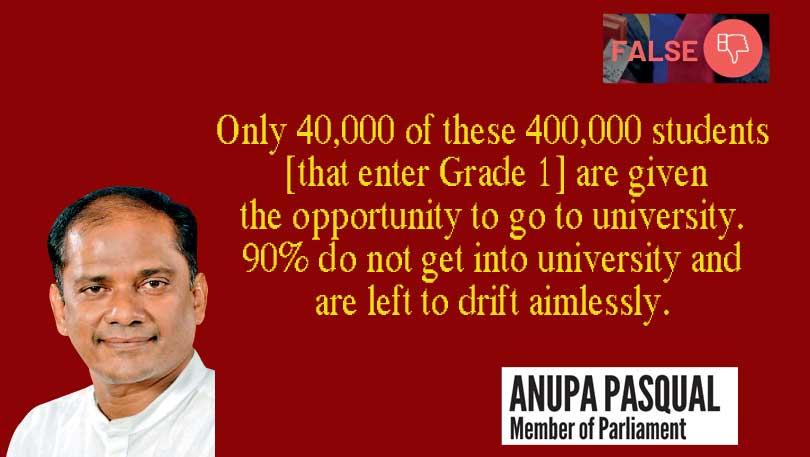Reply To:
Name - Reply Comment

 In his speech, MP Pasqual argues that only a small fraction (10%) of students have the opportunity to attend university and that everybody else, after completing school, is “left to drift aimlessly.” FactCheck.lk interprets the MP’s larger claim to refer to making a case for more state universities.
In his speech, MP Pasqual argues that only a small fraction (10%) of students have the opportunity to attend university and that everybody else, after completing school, is “left to drift aimlessly.” FactCheck.lk interprets the MP’s larger claim to refer to making a case for more state universities.
This fact-check focuses on the statistics cited and the argument made by the MP to support his claim. There may be other arguments in support of his claim that are therefore not evaluated.
To check this claim, FactCheck.lk consulted the Annual School Census of Sri Lanka, statistics presented by the Chairman of the University Grants Commission (UGCPresentation), and the UNESCO Institute of Statistics.
The MP’s claim that students who do not gain entrance to state universities in Sri Lanka are “left to drift aimlessly” is misleading for three reasons:
1.It undercounts the percentage of students enrolled in state universities.
2.It neglects to account for students enrolled in non-state universities and universities abroad.
3.It neglects to account for students pursuing higher education in institutions other than universities.
First, according to the UGC presentation, 43,927 students were admitted to state universities in 2021. This figure is approximately 13% of the 330,488 students that entered Grade 1 in 2008, 13 years prior. This figure is somewhat higher than the share of 10% claimed by MP Pasqual.
Second, the MP limits the number of students pursuing university degrees to university education provided by the state. The UGC presentation reports that in 2021, approximately 25,000 students were enrolled in non-state institutions providing local or foreign-affiliated university degrees. An additional 29,000 students are reported to be pursuing university education abroad. Assuming that annual admissions are one-fourth of total enrollment, this increases the percentage of students admitted to universities yearly by another four percentage points.
Third, the MP also limits the number of students receiving higher education to those pursuing university education. Higher education is a broader category encompassing degrees provided by state and non-state universities, diplomas, and technical and vocational education. The UGC presentation reports that in 2021, almost 16,000 students were enrolled in diploma programmes provided by state and non-state institutions. 35,700 students were also enrolled in technical and technological colleges providing training across diverse vocational trades.
Assuming the average length of all these diploma and vocational programmes is two years, this increases the share of students admitted to higher/further education programmes each by another 8 percentage points. The count may still leave out those enrolled in professional education programmes such as banking and accounting.
The MP supports his larger position by claiming that 90% of those who enter school are “left to drift aimlessly” after school leaving age (without opportunities for higher education). However, the available statistics show that about 25% (13+4+8) of that group are admitted to higher education institutions, making the 90% figure a highly overstated estimate of those who might not have recourse to higher education.
Therefore, we classify the MP’s statement as FALSE.
*FactCheck.lk’s verdict is based on the most recent information that is publicly accessible. As with every fact check, if new information becomes available, FactCheck.lk will revisit the assessment.
FactCheck is a platform run by Verité Research.
For comments, suggestions and feedback, please visit www.factcheck.lk.